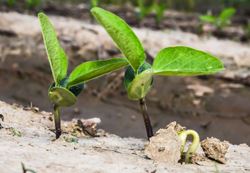|
Plant Breeder Looks For The ‘Perfect’ Soybean
BOSSIER CITY, LA.
The “perfect” soybean would have great disease and herbicide resistance, excellent drought and salt tolerance, be able to withstand insect pests and be high-yielding. And LSU AgCenter plant breeder Blair Buckley is on a quest to find it.
Since 2007, Buckley has been making soybean crosses at the Red River Research Station near Bossier City to find this elusive variety. Ultimately, the perfect soybean may be unattainable, but Buckley is confident that improvements can be made on existing varieties grown in Louisiana.
“So much of plant breeding is a numbers game. There is a lot of material to go through, and much of it does not make it through to the next level,” Buckley said.
It takes a minimum of 10 years to develop a new variety, he said. During this time period, plants are bred and trials are conducted in the field. These field tests must be repeated over the course of several growing seasons to ensure the validity of the findings.
One of the biggest concerns for Buckley and soybean growers is disease. Cercospora blight, caused by a fungus, is the major disease that has been plaguing producers not only in Louisiana but in other Southern states. Disease symptoms first appear as petiole lesions and purplish-bronzing of upper leaves at the late R5 and early R6 soybean growth stages.
Though major symptoms appear late in the season, infection occurs earlier, and the fungus remains latent for a period of time. Severe infections can result in significant defoliation, substantial yield loss and reduced seed quality.

Soybean plant breeders evaluate hundreds of varieties every year in the quest for an improved soybean variety.
Photo by Bruce Shultz
The seed disease purple seed stain is also caused by the same fungus.
“Fungicides have not been very effective in fighting Cercospora, so that means yield loss can be significant,” Buckley said. “We are placing an emphasis on finding varieties that show some resistance to this disease.”
Buckley is examining a few hundred lines and indicated that four to six have shown promise against Cercospora. While not symptom-free, the varieties display symptoms that have been less severe and have come later in the growing season, thereby lessening potential yield loss.
Another trait high on Buckley’s list is drought tolerance. Hot and dry conditions are common throughout Louisiana’s growing season.
“We are looking at material that has shown promise in combating drought-like conditions. This material has slow-wilting lines and conserves moisture better,” he said.
A growing concern is that major aquifers across the South are being depleted. With soybean acreage trending higher, reducing the amount of irrigation statewide can reduce the pressure on these vital aquifers without decreasing the potential yield of soybeans.
Another trait garnering attention from Buckley is salt tolerance. Growers in the north central and northeastern parts of Louisiana have seen high salinity levels in their irrigation water. This has led to reduced yields for farmers who have encountered this situation.
For growers who have access to surface water for irrigation, using it may be a solution. For those who must rely on well water, a salt-tolerant soybean variety is essential to alleviating the problem.
Another recent trend in soybean production has been the increasing popularity of Group IV and V beans. For many years Groups VI and VII were dominant. The switch to Groups IV and V is primarily based on their shorter production schedules. For this reason, Buckley is focusing much of his research on Groups IV and V.
Many growers want the shorter production timeframe to reduce risk and accommodate their farming operation. For example, sugarcane producers growing beans on fallow sugarcane land want those beans harvested so they can begin planting cane in August and September. Earlier-maturing varieties also reduce the risk of being damaged by a tropical storm.
Even with all the attention given to these traits, Buckley said yield is still dominant. “If it doesn’t yield well, nobody is going to grow it,” he said. ∆
|
|